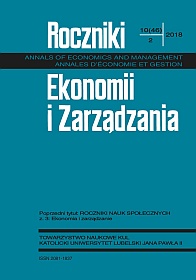Non-agricultural Sources of Income for Families in the Countryside and the Gray Economy
Abstract
For many years, the budget of the rural family, also these including the agricultural farm, has been diversifying sources of income. The percentage of farms receiving income from non-agricultural sources, especially from agritourism, is increasing. At the same time, a high increase of the employment in informal economy (gray economy) is recorded in rural areas, mainly in tourism and gastronomic services, as well as housework (cleaning). The majority of those working in the gray economy treat this work as an additional one, but for many people it is the only source of income. In the opinion of the Central Statistical Office, there were 711 thousand persons in 2014 in the gray economy (the share of employees in the gray economy in the total number of employed persons was 14.5%). The Central Statistical Office’s research indicated: insufficient income and no possibility of finding a legal job as the main reason for taking up work in gray economy. Basic changes in the number and percentage of employees in the gray economy took place after 2004, which could have been related to Poland’s accession to the European Union, and from 2008 to the Schengen area.
References
Charakterystyka gospodarstw rolnych w 2005 roku, GUS, Warszawa 2006.
Charakterystyka gospodarstw rolnych w 2014 roku, GUS, Warszawa 2017.
Fundowicz J., Łapiński K., Peterlik M., Wyżnikiewicz B., Szara strefa w polskiej gospodarce w 2016 roku, Instytut Badań nad Gospodarką Rynkową, Warszawa 2016.
Kabaj M., Zatrudnienie w „szarej strefie” w polskiej gospodarce. Fakty, tendencje, mity i nieporozumienia, Instytut Pracy i Spraw Socjalnych, Warszawa 2004, s. 1, Polityka Społeczna, nr 1.
Praca nierejestrowana w Polsce w 2004 roku, GUS, Warszawa 2005.
Praca nierejestrowana w Polsce w 2014 roku, GUS, Warszawa 2016.
Copyright (c) 2018 Roczniki Ekonomii i Zarządzania

This work is licensed under a Creative Commons Attribution-NonCommercial-NoDerivatives 4.0 International License.


